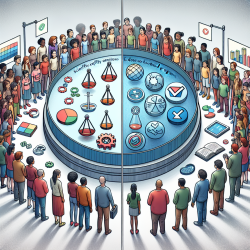Understanding Quantum Time Reversal: A Guide for Practitioners
The concept of time reversal in quantum mechanics has intrigued scientists for decades. The recent study titled "Arrow of time and its reversal on the IBM quantum computer" provides groundbreaking insights into this phenomenon, demonstrating how a quantum algorithm can reverse a quantum state. This blog aims to help practitioners leverage these insights to enhance their skills and encourage further exploration in the field.
Key Findings from the Research
The research conducted on the IBM quantum computer reveals that while time reversal is exponentially improbable in nature, it can be artificially achieved through a quantum algorithm. This is a significant breakthrough, as it demonstrates the possibility of reversing the dynamics of a quantum system, specifically an electron scattered on a two-level impurity.
The study elaborates on the complexity of time reversal, which scales with the dimension of the Hilbert space traversed by the system during its forward evolution. This complexity is quantified by the number of quantum gates required to implement the time-reversal operation.
Practical Implications for Practitioners
For practitioners in the field of quantum computing and physics, these findings offer several practical applications:
- Algorithm Development: Understanding the quantum algorithm used for time reversal can inspire the development of new algorithms that exploit quantum parallelism, potentially leading to more efficient quantum computations.
- Quantum Program Testing: The time-reversal procedure can serve as a tool for testing quantum programs. By reversing the computed state and running the evolution again, practitioners can verify the correctness of the computation.
- Exploration of Entropy and Thermodynamics: The study's insights into entropy production and the arrow of time can guide further research into thermodynamic processes in quantum systems, offering a deeper understanding of these fundamental concepts.
Encouraging Further Research
While the study provides a robust framework for understanding time reversal, it also opens up new avenues for research. Practitioners are encouraged to explore the following areas:
- Time-Dependent Reversal Complexity: Investigating how the complexity of time reversal changes over time in different quantum systems can provide valuable insights into the dynamics of these systems.
- Efficient Quantum Algorithms: Developing quantum algorithms that perform time reversal more efficiently than current methods could revolutionize quantum computing.
- Real-World Applications: Applying these principles to real-world quantum systems could lead to advancements in quantum technology and its applications across various industries.
To read the original research paper, please follow this link: Arrow of time and its reversal on the IBM quantum computer.
Conclusion
The study of time reversal in quantum mechanics not only challenges our understanding of time and entropy but also provides practical tools for advancing quantum computing. By exploring these findings, practitioners can contribute to the development of more efficient quantum algorithms and a deeper understanding of the fundamental laws of physics.










